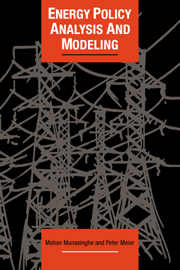11 - Energy-macroeconomic linkages
Published online by Cambridge University Press: 05 March 2012
Summary
As noted in the introduction, the evolution of energy planning in developing countries had as one of its main roots the need to deal with the macroeconomic impact of the sharp oil price increases that occurred in the mid-1970s. For the typical small oil-importing developing country, the most immediate point of impact whenever a change occurs in the world oil price is the balance of payments. How developing countries should adjust to such changes is one of the major problems faced by energy and macroeconomic planners: as we shall see in this chapter, however, modeling such impacts, and quantifying the impacts of the policies that might be appropriate to mitigate the macroeconomic consequences, proves to be exceptionally difficult.
Certainly what one might call “first-order, short-run” impacts on the merchandise trade balance are simple enough to quantify: Expressed as percentages of both imports and exports, we noted in chapter 1 (see table 1.1) the stress that increasing oil import bills have placed upon the merchandise trade balance of developing countries. Indeed, since in the short run structural adjustments are unlikely, a given change in the oil price is very likely to result in a proportional change in the oil import bill.
In 1986 the world oil price collapsed, with prices as low as $10/bbl at their most extreme. This price decline obviously afforded substantial relief to oil-importing countries. Since then, prices have gradually risen, and by the end of the 1980s stabilized in the $18–22/bbl range. Yet the Iraqi invasion of Kuwait in August 1990 illustrated all too well the volatility of world oil markets, with spot prices staying well above $30/bbl for extended periods in late 1990.
- Type
- Chapter
- Information
- Energy Policy Analysis and Modelling , pp. 228 - 247Publisher: Cambridge University PressPrint publication year: 1993



